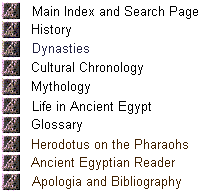
Printout
For best results save the whole page (pictures included) onto your hard disk, open the page with Word 97 or higher, edit if necessary and print.
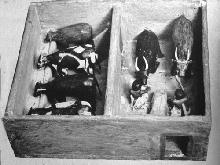
Model of a stable
Source: 'La vie
quotidienne en Egypte' by Pierre Montet
Farmed and Domesticated Animals
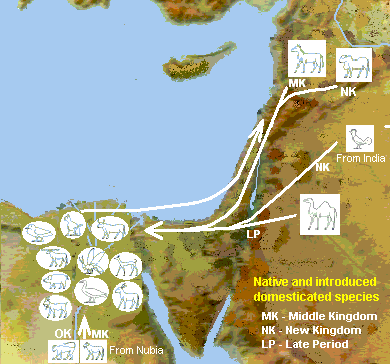 Sheep [1],
goats, cattle, pigs [2]
and geese were raised from earliest times and supplied milk, wool, meat,
eggs, leather, skins, horn and fat. Even the dung had its uses [7].
There is little evidence that mutton was consumed, while domesticated pigs
were eaten at least since the beginning of the 4th millennium BCE [8],
but pork had no place in religious ceremonies. Goat meat on the other hand
was acceptable even to upper class Egyptians. Goat skins served as water
containers and floating devices.
Sheep [1],
goats, cattle, pigs [2]
and geese were raised from earliest times and supplied milk, wool, meat,
eggs, leather, skins, horn and fat. Even the dung had its uses [7].
There is little evidence that mutton was consumed, while domesticated pigs
were eaten at least since the beginning of the 4th millennium BCE [8],
but pork had no place in religious ceremonies. Goat meat on the other hand
was acceptable even to upper class Egyptians. Goat skins served as water
containers and floating devices. The Egyptian farmers, in their early experimental phase, also tried to domesticate other animals such as hyenas, gazelles and cranes, but abandoned these attempts after the Old Kingdom.
The domestic chicken didn't make its appearance until the New Kingdom, and then only in isolated places. It became more common in the Late Period. By then the Egyptians seem to have mastered artificial incubation. Diodorus Siculus (1st century BCE) reports in his Historic Library
Apart from the generally known fashion for breeding these animals, they have an artificial means for raising incredible numbers of chicks. They don't let the chickens incubate their eggs themselves, but through an especially ingenious contrivance, which is just as effective as the forces of nature.Diodor's von Sicilien Historische Bibliothek Vol 1, Chapter 74
after a translation by Julius Friedrich Wurm
![[Image: Forcefeeding goose; Source: MfA]](Ancient Egypt Farmed and domesticated animals_files/forcefeeding_goose_fip-mfa.jpg)
Fattening
Force feeding a goose
Saqqara, 1st
Intermediate Period
Source: W.S.Smith, Country Life in Ancient
Egypt, Museum of Fine Arts, Boston
Cattle
 The Egyptians grew a number
of cattle varieties. Oxen [3]
of a horned African breed were fattened to immense proportions and,
adorned with ostrich feathers, displayed in processions before slaughter,
as shown in depictions at Abydos and Medinet Habu. They also had a smaller
breed, generally hornless, and wild longhorned cattle which resisted
fattening. Zebu were introduced from the Levant during the New
Kingdom [15]
and spread subsequently throughout much of eastern Africa.
The Egyptians grew a number
of cattle varieties. Oxen [3]
of a horned African breed were fattened to immense proportions and,
adorned with ostrich feathers, displayed in processions before slaughter,
as shown in depictions at Abydos and Medinet Habu. They also had a smaller
breed, generally hornless, and wild longhorned cattle which resisted
fattening. Zebu were introduced from the Levant during the New
Kingdom [15]
and spread subsequently throughout much of eastern Africa.The Egyptians developed a number of techniques for rendering these big animals more amenable. Unwanted horn growth was controlled by burning or scraping off budding horns. The story Lion in Search of Man also speaks of nose-piercing:
... an ox and a cow, whose horns were clipped, whose noses were pierced, and whose heads were roped.Sometimes the cattle were branded with red hot irons [14], above all on the great estates belonging to the pharaohs and the temples.M. Lichtheim, Ancient Egyptian Literature, Volume III, p.158
Cowherds tended their animals, sleeping at night near-by in order to prevent theft. When crossing river arms grown over with reeds, they had to be on the look-out for crocodiles and use the right incantations to make the crocodiles blind to the passing herd [17]. If a calving cow was in difficulty, they helped deliver the calf. This herdsman's song was found in a tomb:
You have goaded the oxen on all the roads.In the tomb of Petosiris, the cowherd calls his charges by name: the "golden one", the "shining one" and "beautiful", which were attributes given to the goddess Hathor.
You have walked over the sand.
Now you are trampling on the grass.
You are eating the rich plants.
Now you are sated. May it become your bodies well.
In and near dwellings remains of clover have been found, indicating that the farmers kept their cattle penned up feeding them cut fodder during part of the year, probably during the season of inundation when few grazing areas were accessible [16].
Sheep and goats

 Egypt was cattle country,
like other African lands to its south and unlike the near-by, arid Asiatic
regions where small cattle were preponderant [18].
Egypt was cattle country,
like other African lands to its south and unlike the near-by, arid Asiatic
regions where small cattle were preponderant [18].
The two breeds of sheep found in
Egypt,
the older (left, a depiction of Khnum)
and the one introduced
during the Middle Kingdom from Nubia (right, representing Amen)
... the good shepherd, vigilant for all people, whom the maker thereof has placed under his authorityJ.H. Breasted, Ancient Records of Egypt, Part II, § 900

Wooden rider statuette
18th dynasty
Metropolitan Museum, New York
Horses
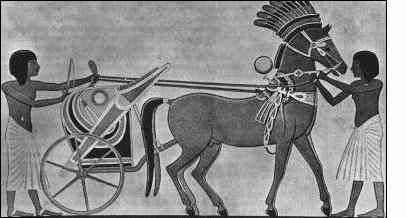 The first evidence of horses
in Egypt dates from the 13th dynasty. But they were introduced on a
significant scale only from the Second Intermediate Period onwards. The
first pictures of horses were made during the 18th dynasty.
The first evidence of horses
in Egypt dates from the 13th dynasty. But they were introduced on a
significant scale only from the Second Intermediate Period onwards. The
first pictures of horses were made during the 18th dynasty. Horses were luxury animals, and only the very wealthy could afford to keep them and treat them according to their worth. They were never used for ploughing and only rarely ridden at the beginning. For war and hunt alike they were harnessed to chariots.
Tutankhamen seems to have enjoyed not only driving his chariot, but also mounting on horseback. This can be inferred from a riding crop found in his tomb bearing the inscription that he came on his horse like the shining Re. According to a few rare depictions, such as a relief in Horemheb's tomb, horses were ridden bareback and without stirrups. The rider sat on the horse's rump, in the fashion donkeys are still mounted today.
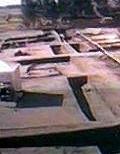 Ramses
II built a complex of six rows of stables for 460 horses at Per-Ramses
on the southern edge of the Delta, covering 1,700 square metres. They had
sloping floors and troughs at the lower end for keeping the floor as dry
as possible and catching the horses' urine. The stables contained stone
water basins and stone tethers.
Ramses
II built a complex of six rows of stables for 460 horses at Per-Ramses
on the southern edge of the Delta, covering 1,700 square metres. They had
sloping floors and troughs at the lower end for keeping the floor as dry
as possible and catching the horses' urine. The stables contained stone
water basins and stone tethers. Pharaohs often supervised personally the treatment their horses were getting. Ramses III frequented his stables and Piye, having conquered the Middle Egyptian town of Shamumu after a lengthy siege, accused the defeated prince Namlot of not feeding his horses properly
As I have lived and loved Re and breath is in my nostrils, thus my heart grows heavy seeing how these horses have been starved, which is worse than anything you have done from the evil in your heart.We do not know how the Egyptians trained their horses, though a teacher's comparison of schoolboys with horses suggests that their approach was rather hands-on:The Piankhi Stela, 23rd dynasty
Horses brought from the field, they forget their mothers. Yoked they go up and down on all his majesty's errands. They become like those that bore them, that stand in the stable. They do their utmost for fear of a beating.Papyrus Lansing
M. Lichtheim, Ancient Egyptian Literature, Vol.2, p.169
Egyptian horses became famous throughout the eastern Mediterranean. The Assyrian conquerors, when extracting tribute, made sure to get as many of them as possible.
Beasts of burden
 Donkeys [4]
were used for transportation,
though sometimes manpower was preferred. They were quite often depicted on
tomb walls.
Donkeys [4]
were used for transportation,
though sometimes manpower was preferred. They were quite often depicted on
tomb walls.
Tomb of Menna, Thebes
Source: Excerpt from
Ancient Egypt by L.Casson
Fish
Ponds, natural or artificial, were stocked with fish. Even gardens often had little pools with fish and water fowl in them.Its west side is a pond for snaring geese of all kinds, a resort of hunters from the very beginning. One of its ponds has more fish than a lake
.....
Fish abound in their basins: bulti-fish, Sna-fish, Dss-fish. The fish are more plentiful than the sands on th shore; one cannot reach the end of themPapyrus Lansing
M. Lichtheim Ancient Egyptian Literature, Volume 2, p.173
Sacrificial animals
There were special farms for the fattening of oxen and Oryx bulls, destined for slaughter. Animals grazed during the day and were driven back to the sheds in the evenings and fed with pellets of corn [5] mash. In the New Kingdom the keeping of Oryx antelopes was abandoned.The fact that beef was part of the diet suggests that some grazing land was available during the times when the Nile receded. While the land was inundated, cattle were brought to the higher levels of the flood plain area and were often fed grain harvested the previous year. Apart from the cattle consumed, much livestock was sacrificed to the gods. Under Ramses III 16,000 cattle and 22,000 geese were sacrificed per year on the altars of Amen alone.
Smaller animals and pets
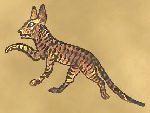
Royalty had royal pastimes and royal pets. Ramses II had a tame lion [9], and Sudanese cheetahs sometimes took the place of the house cat in the king's household.
Cats
Cats seem to have been domesticated during the Middle Kingdom from the wild cats in the Delta or the Western Desert. They spread all over the Near East in spite of a ban on their export. Apart from their usefulness in combatting mice, they were, perhaps more than any other animal except dogs, kept as pets. The first known cat name, Nedjem, dates to the reign of Thutmose III, Amenhotep I's pet Buhaki, is depicted sitting between the king's feet, and Prince Thutmose, son of Amenhotep III, buried Ta-miut in its own sarcophagus.
Apart from being popular cats were also considered divine more than many other domesticated animal. Herodotus describes how the Egyptians mourned the death of a cat and Diodorus Siculus writes of the wrath of the populace when a cat was killed
If its is a cat or an ibis he (i.e. the killer of the animal) has to die in any case, whether he killed the animal on purpose or by mistake; a crowd assembles and maltreats the perpetrator in the most cruel way, and this happens without any decision by a judge.DogsDiodorus Siculus, Historische Bibliothek, Vol. 1, § 83, translated by Julius Friedrich Wurm
My translation from the German
But however much Egyptians loved their cats, it was their dogs they felt closer to, if Herodotus is to be believed
And in whatever houses a cat has died by a natural death, all those who dwell in this house shave their eyebrows only, but those in which a dog has died shave their whole body and also their head.Herodotus, Histories II, 66
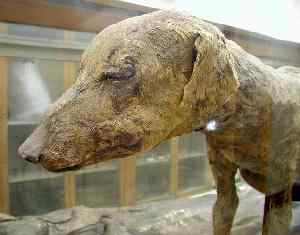 Dogs, while often depicted
as hunting companions or as watch dogs, are never shown merely as pets.
They had individual names [12]
and were often buried with their masters, such as Neb, whose stela dating
to the first dynasty bears his name and effigy. At Abydos part of the
cemetery was set aside for dogs near the graves of women, archers and
dwarfs.
Dogs, while often depicted
as hunting companions or as watch dogs, are never shown merely as pets.
They had individual names [12]
and were often buried with their masters, such as Neb, whose stela dating
to the first dynasty bears his name and effigy. At Abydos part of the
cemetery was set aside for dogs near the graves of women, archers and
dwarfs. At Gizeh the dog Abuwtiyuw, a greyhound-like tchesem (Tzm), received a fine burial:
The dog which was the guard of His Majesty. Abuwtiyuw is his name. His Majesty ordered that he be buried, that he be given a coffin from the royal treasury, fine linen in great quantity, incense. His Majesty gave perfumed ointment and [ordered] that a tomb be built for him by the gang of masons. His Majesty did this for him in order that he might be honored.Inscription dating to the 5th or 6th dynasty
G.A. Reisner The Dog Which was Honored by the King of Upper and Lower Egypt
BMFA 34, No. 206, December 1936, pp. 96-99
Various breeds enjoyed popularity during Egypt's history. A sloughi look-alike with a trumpet-shaped tail was widespread during the Old Kingdom. Short legged dogs were all the rage during the Middle Kingdom while New Kingdom Egyptians preferred the fleet harrier or the small ketket (ktkt-Srj).
Veterinary medicine
Little is known about animal medicine, but their treatment was similar to that of human beings. Among the Kahun papyri there were some about veterinary medicine and a number of treatments have survived at least in part:[Treatment for the eyes (?) of a dog with (?)] the nest of a worm
............... if when it courses (?) scenting (?) the ground, it falls down, it should be said "mysterious prostration as to it." When the incantations have been said I should thrust my hand within its hemu, a henu of water at my side. When the hand of a man reaches to wash the bone of its back, the man should wash his hand in this henu of water each time that the hand becomes gummed (?) until thou hast drawn forth the heat-dried blood, or anything else or the hesa (?). Thou wilt know that he is cured on the coming of the hesa. Also keep thy fingers .............
Treatment for the eyes (?) of a bull with the wind (cold ?)
If I see [a bull with] wind, he is with his eyes running, his forehead ? uden (wrinkled ?) the roots (gums ?) of his teeth red, his neck swollen (or raised ?): repeat the incantation for him. Let him be laid on his side, let him be sprinkled with cold water, let his eyes and his hoofs (?) and all his body be rubbed with gourds (?) or melons, let him be fumigated with gourds ......... wait herdsman ................ be soaked .............. that it draws in soaking ........... until it dissolves into water: let him be rubbed with gourds of cucumbers. Thou shalt gash (?) him upon his nose and his tail, thou shalt say as to it, "he that has a cut either dies with it or lives with it." If he does not recover and he is wrinkled (?) under thy fingers, and blinks (?) his eyes, thou shalt bandage his eyes with linen lighted with fire to stop the running.
Treatment for the eyes (?) of a bull with ushau in winter
If I see a bull with [ushau] in winter, and he is blinded (?) his two eyes are thick; gash thou as above. If I see a bull with ushau in winter from cold, since its arrival in (?) summer, his temples are wrinkled (?), his eyes running, his stomach groaning (?), he does not walk (?) ....................... thou all its body with ........... as is done to one with a bruise (?).Kahun Veterinary Papyrus
Griffith, F.Ll. ed. ; 1898 , Hieratic Papyri from Kahun and Gurob, pp. 13f
[ ] The photo of the mummy of the New Kingdom dog courtesy Jon Bodsworth
[1] Neither the milk nor the flesh of sheep were apparently sacrificed to the gods (no mention of sheep sacrifices in Egyptian sources), though Herodotus claimed that there were exceptions
Now all who have a temple set up to the Theban Zeus or who are of the district of Thebes, these, I say, all sacrifice goats and abstain from sheep: for not all the Egyptians equally reverence the same gods, except only Isis and Osiris (who they say is Dionysos), these they all reverence alike: but they who have a temple of Mendes or belong to the Mendesian district, these abstain from goats and sacrifice sheep.While goats are not infrequently mentioned in the Harris papyrus, sheep are not among the offerings listed.Herodotus, Histories Volume II
[2] Pigs had been eaten since times immemorial and were farmed on a large scale since the New Kingdom.
[3] It is not certain that castration of bulls was practised in ancient Egypt.
[4] Domesticated from the Nubian wild ass, equus asinus africanus.
[5] The corn of ancient Egypt was wheat of course.
[6] Alopochen aegyptiacus
[8] Prehistoric pig bones were found both in the Delta (e.g. at Tell el-Farkha) and in Upper Egypt (e.g. at Abadiya 2)
[9] As did other kings. In the tomb of Maia, wetnurse of Tutankhamen, a (possibly naturally) mummified lion was found.[10][11]
[12] Inyotef II (11 dynasty) immortalized five of his dogs by setting up a stela in their honour, referred to, obviously, as the Dog Stela. The dogs had been given Libyan names, and in a number of cases an Egyptian translation was furnished: Behekay (bHkAi) - Egyptian "Gazelle", Abaqer (AbAqr) which was not translated, there was a "Blacky" - Libyan Pehetez (phtz), a Tekenru (tknrw) and a Teqeru (tqrw).
[13] Cattle were critical as power sources. Ancient Egyptians consumed only little meat, but as food goats, and possibly sheep as well, were at least in some places and at certain times more important than beef. During temple excavations at Tell Ibrahim Awad in the Eastern Delta one fifth of the identified bones were from pigs, 4 percent from sheep and goats and only one percent were cattle bones. (Salima Ikram, American University, Cairo)
According to the Bible the Egyptians were not very fond of shepherds either, though this dislike may have had its source in the fact that many shepherds were nomads roaming the often badly policed semi-deserted border regions:
33 And it shall come to pass, when Pharaoh shall call you, and shall say, What is your occupation?[18] A list in J. Kraus: Demographie des alten Ägypten, p.160, suggests a ratio of three to four heads of small cattle per cow in Old Kingdom Egypt, while tributes from Retjenu (Canaan) during the New Kingdom yielded between six and sixteen sheep and goats for every head of cattle. These ratios are based on a small handfull of sources and should not be taken too seriously.
34 That ye shall say, Thy servants' trade hath been about cattle from our youth even until now, both we, and also our fathers: that ye may dwell in the land of Goshen; for every shepherd is an abomination unto the Egyptians.Genesis, 46
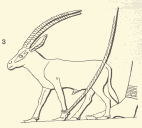 [19] The depiction of
the antelope buck on the right shows clearly the deformation of the
animal's hooves, due to its being kept penned up.
[19] The depiction of
the antelope buck on the right shows clearly the deformation of the
animal's hooves, due to its being kept penned up.
Oryx buck
Tomb of Ty, Saqqara
M. A.
Murray, Saqqara Mastabas, Egyptian Research Account XI, Plate V

